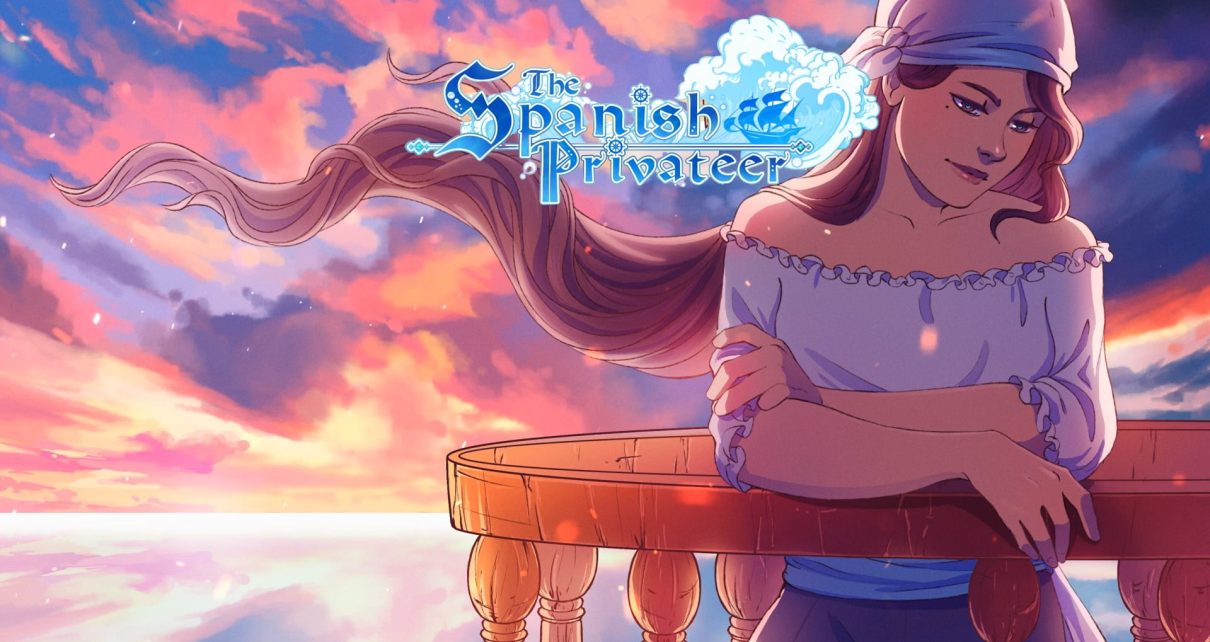The Spanish Privateer first came into view in 2018, when it was a prologue-only demo submitted to the Otome Games Jam. After a successful Kickstarter campaign in May 2021, it has since been expanded into a full game and sailed forth into the world. Released for the PC (Windows, macOS, Linux) in September 2022, this Original English Language Visual Novel (OELVN) marks SinSisters Studios’ debut in the indie otome visual novel scene. A historical fiction centered around pirates who were commissioned by Spain to attack ships that were enemies to the Spanish Empire, The Spanish Privateer provides a 25-hour voyage through three independent routes where adventure, friendship, and romance intersect.
The Runaway Bride Leaves Her Past Behind
The story of The Spanish Privateer follows Isabel Carlota de Castilla (name cannot be changed), an 18-year-old who ran away from home one day to flee a forced marriage. Dressed as a lady as one from a rich family of the 17th century Spain would, Carlota makes her way aboard La Aguja, a privateering ship with an all-male crew where she is immediately turned away by the quartermaster. Determined to not return home and be forced into the arranged marriage, she continues to fight for her chance for the freedom she so yearns. Eventually, Carlota obtains the captain’s approval to join the crew, and that is when our protagonist’s eventful journey truly begins.
To a Future of Friendship, Romance, or Something Else
The Spanish Privateer features three male love interests, namely Flint the quartermaster, Lark the lutist, and Rico the captain. All three romance routes are available from the first playthrough and their storylines are independent of one another, but certain routes reference information from the other routes. Hence, for a spoiler-free experience, the play order as officially recommended by the developers is Flint first, then Lark, and Rico last.
Using a more standard structure for its story branching, The Spanish Privateer starts off with a General Route where you will have to gather enough friendship points via your choices to get onto a particular character’s romance route. The story is not split by chapters, however, and the three romance routes are of varying lengths; Rico’s route is the longest, followed by Lark’s route and finally Flint’s route. To give a clearer idea, the time I took to play through Rico’s route was twice that of Flint’s route, and Lark’s route was roughly an hour longer than Flint’s.

Every romance route in The Spanish Privateer has a Good Ending (with an epilogue), two Bad Endings, and two or three Alternate Endings. Although some of the Alternate Endings can be seen as a bad ending due to their non-ideal circumstances, the Bad Endings generally highlight situations where a relationship is no longer possible for the pair — such as the Bad Ending one gets when they did not accumulate enough friendship points for any specific love interest by the end of the General Route. To me, the Bad Endings were not worth unlocking due to how little they added to the story. Some of them were also abrupt closures especially when nothing in the narrative hinted that you were en route to a Bad Ending. Alternate Endings, on the other hand, are worth checking out in general as they are not just comparatively longer but also showcase some interesting outcomes and provide further insights into various major characters’ relationships. Nevertheless, only the Good Endings end on a happy note whilst the Alternate Endings are sometimes bittersweet and the Bad Endings are naturally joyless. Those who wish to play The Spanish Privateer for only its Good Endings can do so; there is no requirement to get other endings first before the Good Ending can be achieved. Regardless of your preference to find the Good Endings only or hunt for all the endings and complete all the 21 in-game achievements, a walkthrough guide — which can be found inside the paid Digital Bundle DLC — is recommended.
In The Spanish Privateer, the ending one gets is determined primarily by Carlota’s Friendship and Romance meters with each of the love interests, and in a few cases, certain choices picked. It may sound similar to the usual system used in plenty of otome visual novels, but in this case, Carlota’s Friendship and Romance meters with the chosen love interest and her Friendship meters with the unselected love interests are assigned with equal importance. For example, to get the Good Ending, one must maximize the Friendship and Romance meters with the chosen love interest as well as the Friendship meters with the remaining two. Moreover, some choices that boost romance points with the selected love interest will dock friendship points with someone else, which make the system trickier to navigate through even though the consequences of said choices are actually logical in the story.
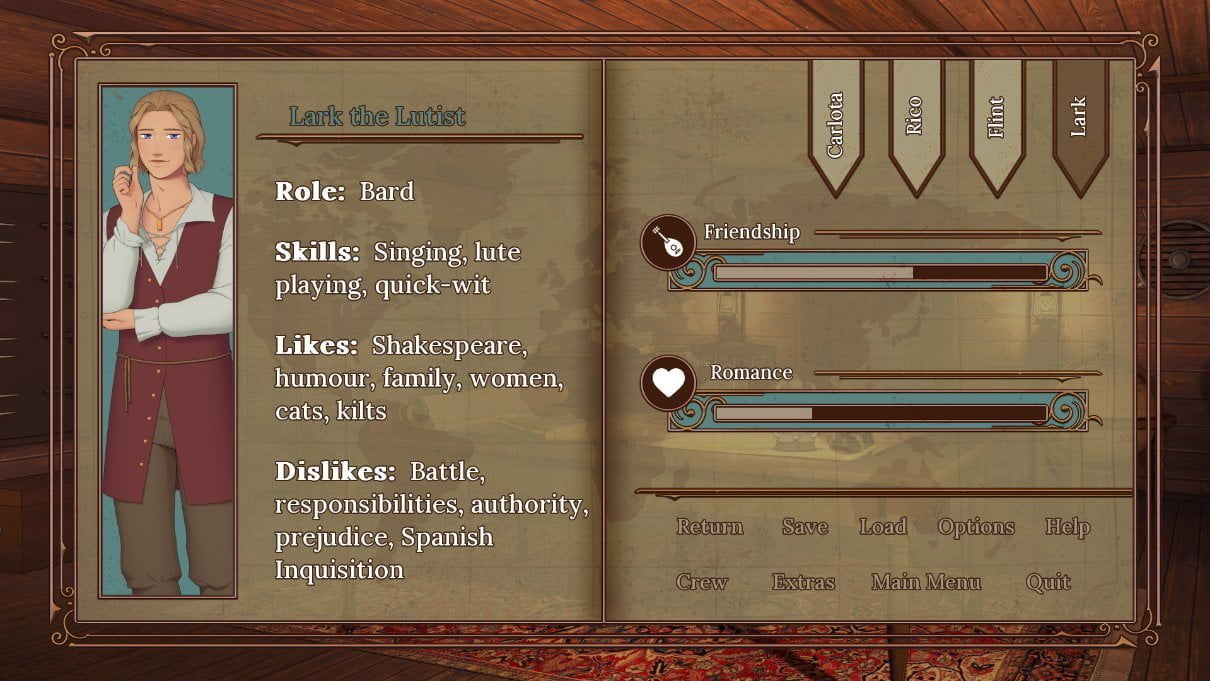
While The Spanish Privateer’s approach to its Romance and Friendship system has been a welcome surprise, its inclusion of a Personality system for the protagonist was a questionable move. Carlota is given three broad personality alignments: polite, witty, and bold. Choices reflective of the three different personalities are found throughout the visual novel but most of the time, only one of them gets you to the Good Ending. And though each love interest has a strong preference for a particular personality in Carlota, several choice menus during the individual romance route still include choices — or trick choices, more like — for the other personalities. Due to the way it was set up, the Personality system felt like a farce that seemingly did something nice but really did nothing substantial.
Flint the Quartermaster who Grants No Quarter
Flint is the first crew member Carlota meets when she tries to seek passage aboard La Aguja. He makes no effort to hide his displeasure towards Carlota upon hearing her request, and certainly not after the captain allowed her to join them. Still, Flint tolerates Carlota’s presence out of respect and consideration for the captain and treats her the same as he does with the rest of the crew. With his wariness of women and strict business-only attitude, Flint is not particularly easy to approach for the newcomer. Nevertheless, that does not stop the protagonist from trying to befriend him and understand his position.
Flint’s initial behavior put me off so much that I did not even consider picking him for my first route despite finding his prim appearance attractive. However, my interest was eventually piqued while playing the lutist’s route where there was an endearing scene involving this otherwise stern quartermaster. And Flint’s route certainly did not disappoint me in highlighting his sweet, caring, and loyal sides. It was encouraging to watch the normally stoic Flint express more of his personal thoughts and emotions as he began to trust Carlota more.
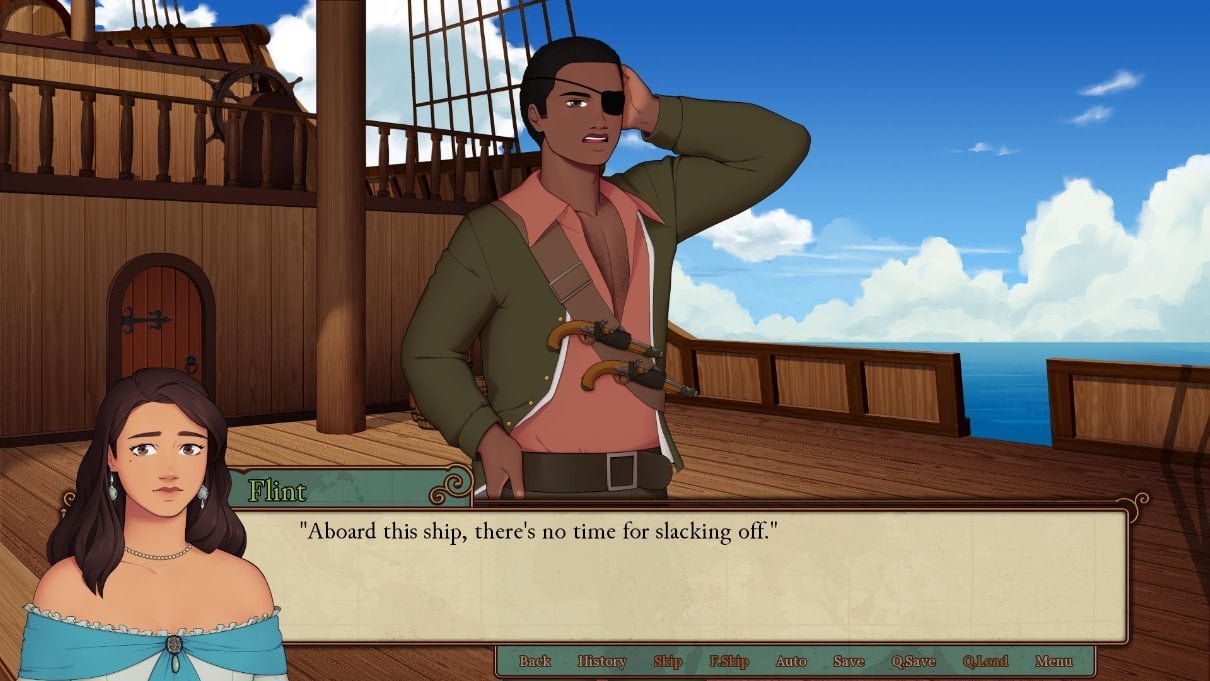
Flint’s route did disappoint me in some other aspects, though. In fact, I find it to be the most forgettable route in The Spanish Privateer. The ups and downs in the plot were often not intense enough before they soon calmed, making the whole story feel like there was not much at stake after all. Dialogues between Flint and Carlota were also monotonously straightforward throughout without any especially memorable characteristics that would create a refreshing spark in certain moments. I was also baffled by Carlota’s crude underhanded method in dealing with a particular problem for Flint at the end, which left me feeling unsatisfied towards its resolution. All in all, Flint is a pleasant character to fall in love with but his route unfortunately did not match up to the same level of loveliness.
Lark the Lutist who Spars with Wit
Hired as a bard aboard La Aguja, Lark is a bubbly Scot who never lacks a smile on his face and some flirtatious words to spare. Even as he shows Carlota around the ship as part of his serious duty, he does not miss the chance to flirt with this new crewmate. Yet behind his sunny disposition and playful teases hide secrets that he holds close to his heart.
Flirty characters are mostly not my cup of tea, so it is hardly a surprise that I was not too fond of Lark at first. But during his route, when his flirtiness was curbed and his wittiness shone through instead, I found myself starting to like him more. It was a shame I did not know enough Shakespeare to appreciate the quotes used by Lark and Carlota for their light-hearted retorts. Nonetheless, I enjoyed the multiple moments when the pair pitted their wits against each other as those were some of the most lively and mirthful exchanges in The Spanish Privateer. Lark’s route even has a few meta references sneakily slipped in, which contributed to its overall fun factor.
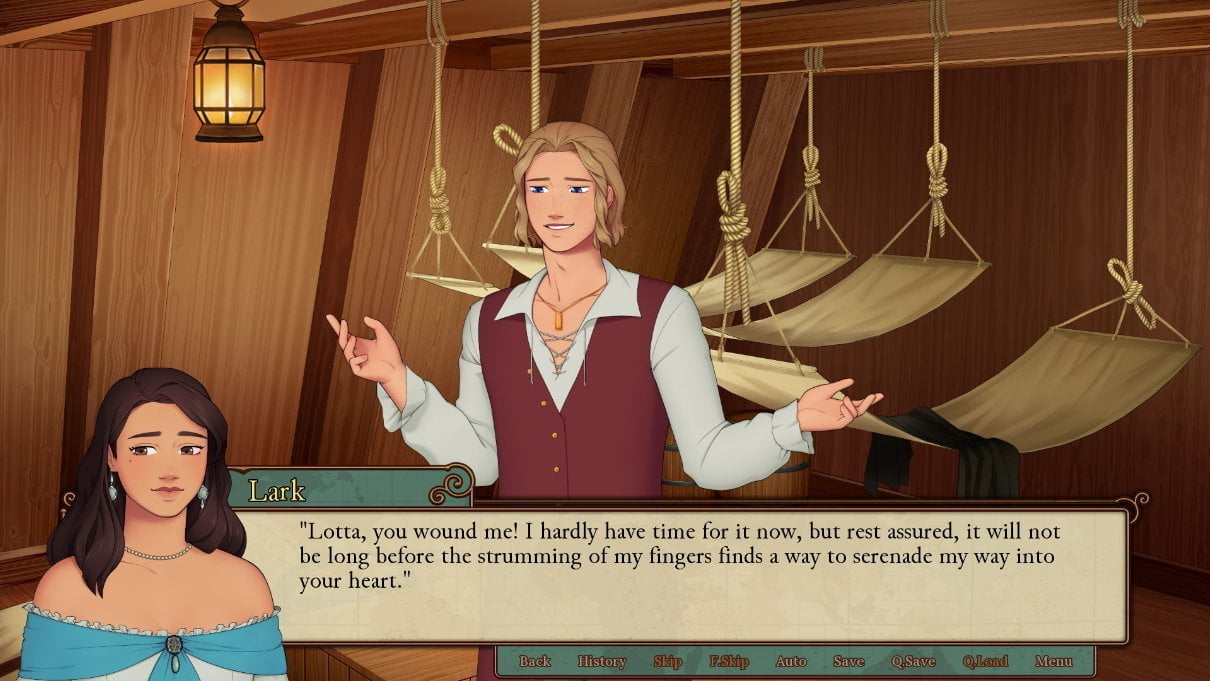
Naturally, Lark’s route is my favorite of the three. Lark and the protagonist share not only a wonderful chemistry throughout, but also some sweet romantic tension, especially in a CG event early in the route. Not to mention, this route has been an engaging read with its charming humor and entertaining banter. In addition, Lark’s vivid retellings of his stories were pleasantly captivating even when they were presented in the text-only NVL mode lasting over several minutes. However, there was a particular character conflict in the storyline that felt like it came out of nowhere due to a disconnect with prior information and a poor lead-up to it. Otherwise, I find Lark’s route to be quite well-written and his epilogue to be warm and fuzzy.
Rico the Captain who Hails from Puerto Rico
A well-kempt man with a gentlemanly demeanor, Rico is the Spanish privateer captaining La Aguja. When Carlota steps into his cabin wishing to speak with him, Rico is surprised to see a woman on his ship but does not straightaway dismiss her. And despite his ship’s name, becoming a member of his crew is apparently not a difficult needle to thread for the captain quickly agrees to let the lady join them after hearing her out. He does not even mind that Carlota has zero sailing experience, noting that she just needs to be willing to learn and help around the ship diligently. Thanks to his big-heartedness, Carlota can now fulfill her wish and experience what life sailing at sea is like.
Since he is more courteous than Flint and more serious than Lark, Rico automatically gave me the best first impression. Alas, my opinion of Rico did not notably strengthen over the course of his route, but neither did it weaken. Rico’s personality and background were fleshed out within the route and while the information allowed me to understand the captain better, it just did not make me feel strongly about him. There were times when his thoughts amazed me and his actions disappointed me, but none of them were compelling enough to change my opinion of him for better or for worse. Throughout his route, Rico simply stayed as an amicable friend in my heart.
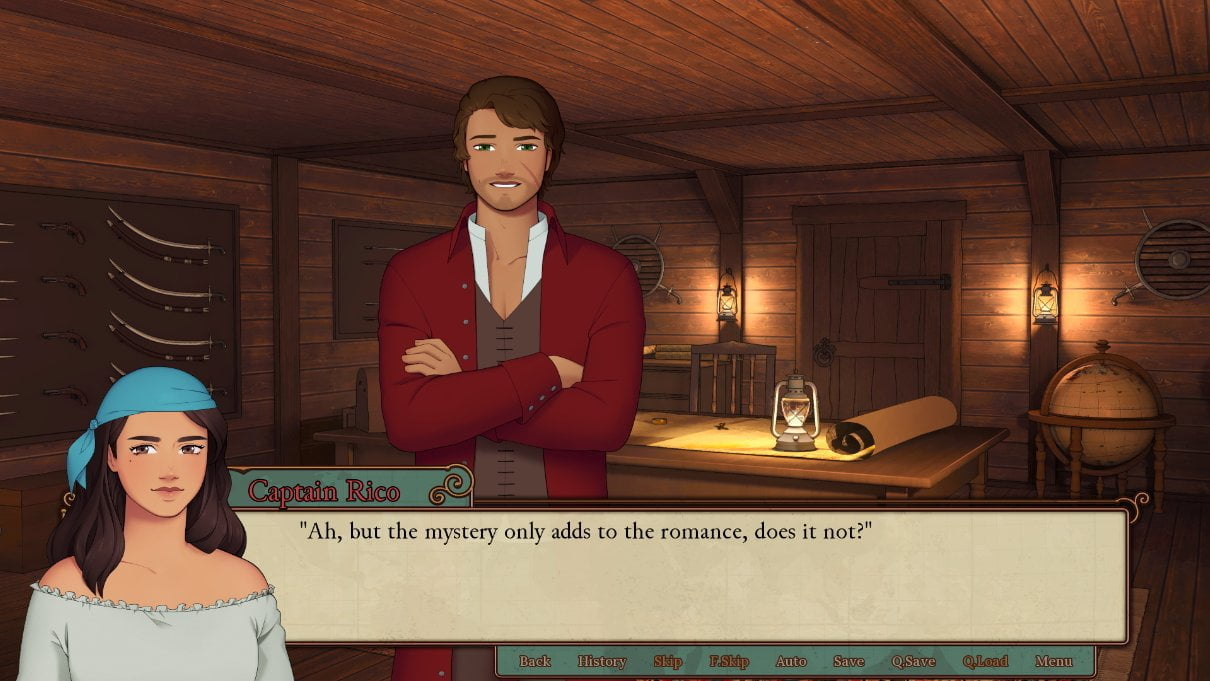
The swift succession of story events did not help matters either. Rico’s route generally seemed like it tried to tackle many different things at once without placing equal purpose to every section, which resulted in some parts feeling more significant whilst others felt more like convoluted and windy fillers. There were a few intriguing plot events in the route, including a particularly emotionally intense scenario in its opening arc, but plenty of the smaller moments were unfortunately swept away by the swarm of bigger events. Thankfully, the closing arc of the story weaved meaningful connections back to a few earlier passing events, making certain points of the story form a beautiful and satisfying loop.
Carlota the Lady who Chases after Her Dreams
From the way she vehemently rejects the arranged marriage and then escapes on a privateering ship she has heard of beforehand, Carlota proves herself to be someone who not only knows what she wants for herself but is also resourceful enough to set her plans in motion and achieve her goals. Even though she comes from a well-to-do family, Carlota is not averse to picking up the mundane physical work required around the ship to earn her keep. She learns the ropes fast as well, which is a given with how quick-witted and hardworking she is.
Of the three broad personality alignments Carlota has, I like her witty side the most. The magic especially sparked when the character she was talking to had as much wittiness to parallel hers. And if only The Spanish Privateer has allowed inconsequential roleplaying, the dialogue choices tagged to Carlota’s bold personality would have been a fun set of choices to toy with since some of them elicited rather amusing responses from the other characters. In contrast, the polite dialogue choices were the least interesting with how predictably safe the following conversational outcomes were.

Although Carlota has several positive character traits, she also makes mistakes as expected of a teenager who ventured out of her home country on a ship for the first time in her life. In spite of her ignorance about certain things, such as not realizing how strict the rules for a sailing crew can be, Carlota is certainly receptive to learning new things. Still, there were times when her actions leaned towards brash and rude. For instance, in both Lark’s and Flint’s routes, she meddles in the love interest’s personal affairs. While I was forgiving of her unsolicited intervention in Lark’s route, I was less accepting of the same in Flint’s route. First, the method she used in Flint’s route was more extreme and crossed more boundaries. Second, the story did not provide sufficient insights into the situation and the characters involved to convince me that the aforementioned method was Carlota’s best or last resort to the issue at hand. Seriously, I was very much perplexed that Flint did not have a bigger reaction to the stunts Carlota pulled.
Further Thoughts About the Writing
For a historical fiction work, The Spanish Privateer’s writing presents the 17th century in quite a bit of detail. Through Carlota’s conversations with different characters, we are informed about the broader political situation where big European powers such as Spain and Great Britain were fighting for more colonies. We also get to hear the more specific accounts of different characters’ experiences as a result of colonization. This is in addition to several characters knowing at least two languages and the story mentioning a few religions, both of which illustrate the spread of the various colonizers’ languages and religions at that time. The real-world history presented in this otome visual novel evidently adds to the world-building, but due to the scattered and partial delivery of information that explains just enough for the narrative’s purposes, it is not exactly effective as educational material.
Barely knowing anything about 17th century Europe before I began playing The Spanish Privateer, I found the history relayed through the writing difficult to digest. Characters would casually drop bits of information, sometimes showing that they know certain contexts I do not. It is not at all far-stretched for the characters to be keeping abreast of their region’s current affairs, but it can be tough to fully appreciate the history-heavy portions as is when some of the background information is not supplemented in any way within the game.

Now, this OELVN does have a Dictionary system that explains various non-English and archaic English terms used in its story, and a handful of entries shed light on their historical contexts. However, the Dictionary’s coverage is limited. While what it currently covers is apt and helpful, there are still some things the main text skipped over that I wish were noted somewhere in the Dictionary. For starters, it would have been great to know explicitly when The Spanish Privateer took place. The story hints at the time period through sporadic recollections of past events and references to early Baroque-era composers. Even the existence of privateers is already a hint. But at the end of the day, knowledge of Western history is still needed to piece these hints together and surmise that the setting is in the 17th century.
Similarly, a regional map that highlights the places brought up in the story would have been a valuable addition, and perhaps especially so since the characters are always traveling around and they mention other places frequently.
I may not have understood the historical contexts in The Spanish Privateer completely until I looked into them, but that does not take away the point that the writing is pretty well-researched for the topics it incorporated into the story. As an additional case in point, nautical terms are used appropriately, making the whole “I’m a crew member on a ship” business feel authentic.

Another commendable aspect of The Spanish Privateer’s writing is its emphasis on friendship in all the romance routes. Rather than conveniently writing off the main character’s and the love interest’s social lives after they got together, the writing respects their individualism. Moreover, the couple’s friendship with the others is not a mere speck of the story but is integrated as an indispensable core to the romance route. As mentioned, one of the criteria to get the Good Ending is to have maximized Carlota’s Friendship meters with everyone. This approach helps to cement the perception that no one in the story is living in a vacuum and that nobody’s world shrinks just because they found someone they like romantically. At the same time, it adds depth to the major characters’ relationship dynamics while rendering the characters more real.
On the whole, the writing in The Spanish Privateer is good. The text has very few typos and the story events have a logical natural flow to them. I particularly love the NVL-mode segments in Lark’s route where the prose is written with elegance and craft. I also appreciate the sprinkles of non-English words in the narrative, which paint a fuller picture of the character’s background without being superficial. However, there was a non-English line that looked awkward because it is a language written right to left but was forced to appear in the same left-to-right style set for the entire game’s text. The writing also relied more on telling than showing, thereby causing some conversations between characters to sound lengthy and quite on the nose.
Sightseeing on La Aguja: The Visual Aspect
Whether we are considering the art style or its usage of the art assets, The Spanish Privateer adheres to a theme: simple and straightforward. From the User Interface (UI) and character sprites to the background art and CGs, there is nothing extraordinarily striking but they do their jobs satisfactorily.

The UI design reflects the globe directly through its yellow-brown and aquamarine hues, and the world map that is faintly visible in the background of various text boxes and menu screens. Placeholder images for unseen CGs show a compass rose, which adds a splash of nautical theme to the UI design. The Spanish Privateer also uses clear-cut sectioning and pagination for all its menu screens, like the unmissable bookmarks on the Crew menu screen for navigating to the individual characters’ pages. Most of the menu screens looked all right, though the Gameplay Options screen was kind of cramped, and the bold text on the History Log was difficult to read.
Character sprites have clean line art and soft shading, which gives them a crisp and smooth appearance. Their eyes and mouths are not animated but they have a variety of facial expressions that are used liberally throughout the game. Furthermore, each major character’s sprite comes in two unique poses along with two to three outfits to suit the occasion. I am impressed by the meticulous use of Flint’s character sprite, where he is seen wearing his eyepatch outdoors and not wearing it indoors. Carlota’s side portrait confused me a few times, however, because her facial expression did not always correspond to what I was expecting after making some dialogue choices; I have no idea if Carlota was great at masking her true feelings or if I totally misread the tone of those choices. But perhaps neither of these can rival the startle Lark’s character sprite gave me when he suddenly plunged downwards. Yes, what a dramatic plopping down to bed performed by the dramatic bard!
Unlike the UI design and character sprites with a certain uniformity to them, the background art and CGs are more varied in their visual styles. The background art in particular is quite an assortment of landscape illustrations with rendering levels ranging from less precise to more detailed. This variety is expected given that the background art is sourced from different artists. Nonetheless, there is effort in ensuring that the final collection shares similar stylistic characteristics so the different pieces still complement one another reasonably well to produce a harmonious look. Sadly, The Spanish Privateer’s library of background art is ultimately insufficient for its story, as seen from the same background art being reused for several locations. That said, there is some creativity observed in how a few of them are handled. For instance, the same ship deck background is used but flipped horizontally to indicate the scene is happening on a different ship.

There are two kinds of event CGs in The Spanish Privateer. One is the regular, non-chibi style illustration, and the other is a smaller insert art drawn in chibi style. Every route has a mix of seven regular CG bases and three chibi CGs, but their usage within the individual routes did not follow the same pattern. In Flint’s route, all the three chibi CGs are tagged to the early sections of the story, which threw me off as I thought it meant his route was going to contain more chibi CGs than regular ones. In addition, there is a chibi CG in Lark’s and Rico’s routes whose subject is neither the protagonist nor the love interest, and I felt that was quite a waste of the already scarce chibi CG slots.
Personally, I like the chibi CGs more because the characters are basically more cute in that style. As for the regular CGs, I have mixed feelings about them; I believe the anatomy, especially the side profiles of the faces, could be better in some pieces but I enjoy the thoughtfully applied lighting and colors for the most part.
The Privateers’ Shanty: The Audio Aspect
As with its visual aspect, The Spanish Privateer’s audio aspect is serviceable. This otome visual novel is not voiced, which I did not mind though I did imagine it would have been nice to hear those non-English words in the dialogue lines. In any case, the 20 background music (BGM) tracks have helped intensify the moods of various story moments, and the sparse sound effects have brought specific venues to life.

Similar to the case for the background art, The Spanish Privateer’s music is a compilation of different composers’ pieces but they all share the same Western orchestra instruments. A number of the BGM tracks fittingly bring jolly pirates, carefree seafaring, or lively taverns to mind. What’s more, all three love interests have their own character themes as well as distinct BGM for their own Good and Alternate Endings, which made the character-centered moments even more special to each of them.
Content Rating and Accessibility Aspects
On the Steam page for The Spanish Privateer, the following mature content description is provided by SinSisters Studios: “This game contains text descriptions of violence, blood, and death, mild visuals of blood, text descriptions of mildly suggestive sexual content, and descriptions of alcohol consumption.” In-game, there is a Content Warning screen that additionally lists coarse language, racism, antisemitism, enslavement, and systematic oppression. There is also a more detailed but not spoiler-free list provided under the Content Warnings section of the game’s Options menu.
Additional content warnings I would supplement here include: bodily fluids and waste, gambling themes, partial nudity, pregnancy, and tobacco reference. Visual-wise, there are occasional screen shakes. Sometimes, the background art is blurred and some other times, camera panning and/or zooming animations are used on the CGs. In one case, the image bobs continuously for the duration of that particular scene. These animation effects cannot be turned off.

Under the Gameplay section of the Options menu, there are sliders for tuning the text speed, auto-forward time, music volume, and sound volume. There is also an option to underline foreign and archaic words that have entries in the Dictionary system, a function I found really helpful though the presentation of the option’s on/off states was not intuitive. I also wish the text box’s background color could change when it is showing the Dictionary entry just so it would be more immediately obvious that the text box is currently showing a Dictionary entry and not a part of the narrative. On a side note, a link to a dictionary term in Lark’s route is broken.
Under the Accessibility section of the Options menu, players may choose the font (i.e. default, OpenDyslexic, Helvetica, Arial, or Verdana), quick menu size, and color contrast. There are sliders for adjusting text size and line spacing as well. However, some configurations of the text size and line spacing will cause the longer lines to flow past the text box’s bottom border, and in NVL mode, an entire paragraph can go out of screen. If the custom text settings have to be kept, then the only way to know what the out-of-screen parts read is to refer to the History Log, which as mentioned is difficult to read because the text is all in bold.
The quick menu may be altered to default, medium, or large size, but the bigger the quick menu is, the fewer navigation links it shows. The disappearance of certain navigation links may confuse some while changing the quick menu size. Still, it is a good thing that the top navigation link “Menu” is preserved for all quick menu sizes. The next handy function — Fast Skip, which allows players to skip the read text and go right to the next choice — is also always a part of the quick menu.

Built with Ren’Py engine, The Spanish Privateer retains the default infinite manual save slots. The shortcut keys, such as “Esc” for accessing the save menu and “Tab” for the skip function, are unchanged. Both keyboard and mouse controls are supported here too.
Verdict
Transporting players to 17th-century Europe, The Spanish Privateer brings forth a historical fiction that combines eventful seafaring life and heartening friends-to-lovers romance. Although the storytelling is dull at times due to too much telling and little showing, the story itself is filled with interesting and unexpected events that keep the momentum and curiosity going. The three male love interests you can pursue in this otome visual novel each has his unique personality and backstory. Regardless of who you choose to romance — the strict quartermaster, the eloquent lutist, or the genial captain — there is always somewhere new to be explored and something more to be discovered about the crew. The visual and audio aspects may not be this indie title’s top strengths, but if you enjoy historical pirate stories with romance brewing steadily over time, then The Spanish Privateer could be the port to your next fresh journey.
WAIT FOR SALE ON THE SPANISH PRIVATEER
If you would like to see more Visual Novels, you may be interested in our review of Bustafellows. Or some of our other Otome reviews.
Many thanks go to SinSisters Studios for a PC review code for this title.

A person with many hobbies (and even more WIPs), KuroKairin plays, playtests, and reviews PC games. She loves games with good stories that bring her on an emotional and thought-provoking journey. Her favourite genres include otome visual novel, point and click, puzzle, and RPG. Follow her @KuroKairin.

